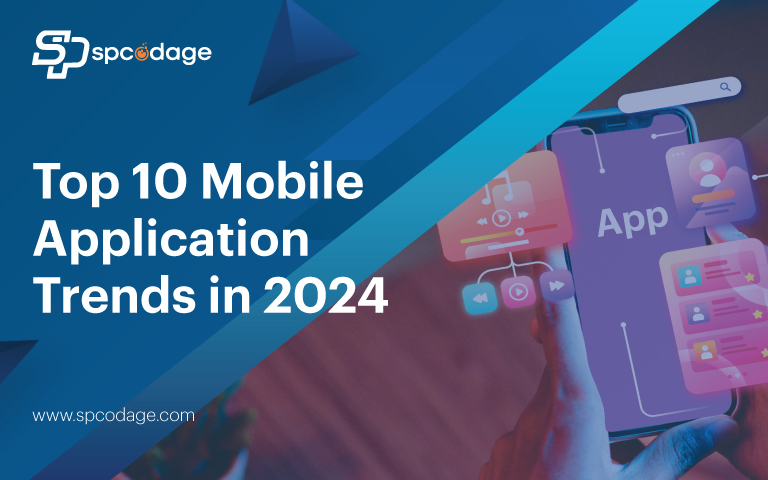Development of software and mobile apps can be a useful digital strategy for your company to gain new clients and increase productivity. The market for mobile applications is on the verge of reaching $614.40 billion by 2026. Massive obligation to adapt to shifting market standards comes along with all the potential revenue.
While app solutions have served as a one-stop shop for end users for more than ten years, business needs and technological advancements happen at a breakneck pace. As a result, trends in mobile application development have become more inventive and difficult.
In order to give your clients the greatest possible experience, it is therefore imperative that you stay up to date on the current trends in mobile app development if you want to use them to increase your online presence.
Top 10 Trends in Mobile Application Development to Keep Up With
1. 5G Technology
App development trends in 2024 will be significantly impacted by the 5G deployment. This technology has the potential to revolutionize the creation and use of mobile applications for developers.
What does this mean for the development of mobile apps?
Efficiency and speed will increase significantly. It is anticipated that 5G would increase traffic capacity and network efficiency while delivering a 10x reduction in latency. 5G is expected to be up to 100 times quicker than 4G, depending on the mobile network provider.
5G adoption will improve mobile app functioning. As a result, developers will be able to update apps with new features without compromising their functionality.
2. Artificial Intelligence
As far as mobile apps are concerned, AI has only been incorporated into chatbots, photo editors, and virtual assistants; however, by 2024, this will change.
First of all, it has the potential to greatly streamline the mobile app creation process. It has the ability to generate a mobile application without instructions if it is given information about a prior mobile app development process. Real-time AI integrations can assist in resolving issues that may arise with the app. Secondly, by adopting preset patterns, AI can mimic user behavior.
In this way, we can deploy apps with AI built into them to monitor all of our possessions and feed in the essential data to our mobile devices.
3. Beacon Technology
Beacon technology, a popular trend in mobile app development, provides proximity-based location services by utilizing Bluetooth Low Energy (BLE) devices. Beacons are small wireless transmitters that may establish a connection and exchange data with neighboring mobile applications.
Developers of mobile apps can provide users with customized offers, notifications, and information based on their real location by including beacons into their apps. Beacon technology improves consumer experience, fosters more user connection, and opens up new avenues for innovative app development in a variety of sectors.
4. Chatbots
Chatbots have developed and become far more advanced over time. Customer demand has led to a rise in the use of chatbots on websites. It’s evolving as the new benchmark for client support.
However, just a small number of the millions of apps that are available on the Google Play Store and Apple App Store truly make use of chatbots. 2024 will see a change in this.
As AI technology powers chatbots, their reactions are starting to resemble those of real people. This is one of the reasons AI will continue to grow, as we have already mentioned.
5. Applications for Foldable Devices
Recent years have seen a resurgence of foldable devices. Foldable smartphones such as the Samsung Galaxy Fold, Huawei Mate X, and the redesigned Motorola Razr were released in 2019.
Depending on the choices of the user, these smartphones can fold to reduce or increase the screen size. For instance, a user may unfold the gadget to see a video on a larger screen while making a call.
When developing or updating an app, resellers and content creators must take these devices into consideration.
Roughly 3.2 million foldable phones were shipped in 2019, according to Statista. App developers need to prepare for the fact that foldables will undoubtedly have a significant impact this year.
6. Gamification
You must completely rewrite your mobile app and implement a gamification strategy if you want to increase engagement rates. It’s a technique for creating appealing and captivating applications that incorporate gaming aspects.
You may create apps with gamification that engage and focus users. In 2024, this popular trend in mobile app development is expected to persist. It enhances the overall user experience, encourages consumers to use the app again, and extends their enjoyment of it.
7. Touchless UI
Instead of relying on touch-based user interaction, it uses voice recognition technology to carry out standard application activities. The idea behind touchless user interface is that user applications can be instructed by their users. Apps that use speech-to-text and text-to-speech technologies, for instance, may understand voice commands from users and deliver the content they’re looking for.
8. Motion Design
Users of your app may become distressed with constant, intricate designs that encourage no interaction. Motion design is one way to solve this. To “grab down” your user’s attention is the aim. Icons with motion design contribute to engagement, interactivity, animation scrolling, and macro interaction.
9. Predictive Analysis
Predictive analytics uses data to forecast occurrences through the use of AI, machine learning, data mining, and modeling technologies. It will be used for many different types of mobile apps on a wider scale in 2024. The main goal is to use an app to improve the UI/UX.
10. Internet of Things Integration
The Internet of Things (IoT) refers to the expanding network of gadgets that are linked to the Internet and offer customers automated control and convenience. One prime example of the growth of mobile app development and the Internet of Things is smart home technologies.
Mobile apps can be used to connect to home security systems, lock or unlock front doors, and control thermostats in houses from a distance, and can be linked to other household equipment.
Conclusion
Relying on data from two or three years ago when developing apps now will make it impossible for you to remain competitive. The success of your project might be determined by the trends in the mobile app business.
You can take the 2024 mobile app development trends as a guide if you’re a reseller or mobile app development company. It is imperative that every mobile app developer in your team comprehends current trends in mobile app development and integrates them into the app development workflow.



